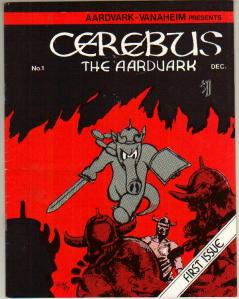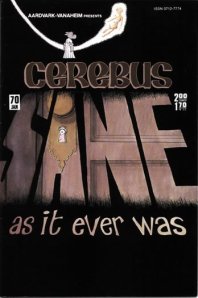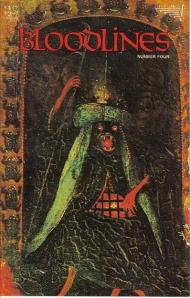Although much has been recorded on Cerebus the Aardvark, including a Cerebus wiki, a great fan site and Dave Sim’s own website, I’m going to cast my own post on the topic. Seeing as how you could just look up any questions you have regarding the “Earth pig born” on either of the above or more, I’m going to narrow down my post to include only the early history on the production of the comic, or, Cerebus Origins.
At the end of 1977, the first issue of Cerebus was released to the world on a bi-monthly basis from Kitchener, Ontario. Published by Denise “Deni” Loubert under Aardvark-Vanaheim productions, with Cerebus creator, writer and artist Dave Sim owning equal portions of the company. The couple set off publishing limited print runs of the 24 page comic. Based off the logo of the company coupled with Loubert’s misspelling of the mythological character Cerberus, the comic’s birth is a charming one.
As administrator and publisher of the comic, it was Loubert who wrote the editorials on the inside cover, and she who announced their marriage in the editorial of issue 7 of Cerebus. During the first few years of publishing, Deni orchestrated the production of much merchandise including a Cerebus plush toy, buttons, and T-shirts as well as starting the fan-club and organizing the distribution of subscriptions.
After two years, in March of 1980, the comic began to be published monthly. Shortly after, and because of the attention and success the comic was achieving, Deni and Dave began to include a line of short comics to the end of the Cerebus comic, and increasing its pages to 32. The line was called “A Unique Story” as a main header and featured several artists and their work which I will post a little later.
Unfortunately nothing lasts forever and Deni’s issue 55 editorial gave testimony to her and Dave’s separation. This separation did not reflect in the success of the business which was producing more merchandise and acquiring ever more subscriptions. The couple continued to attend many exhibitions and conventions throughout the year and readership only continued to grow.
Around 1984 the company began to publish some of the comics featured in the “Unique Story” section such as Neil the Horse by Arn Saba and Flaming Carrot by Bob Burden. Also, in August of 1984, Gerhard joined the team, producing magnificent backgrounds for Cerebus which was still the focal point of the company. Finally, in December of 1984, the company released AV in 3D, a 3D comic with Aardvark-Vanaheim favourites complete with 3D glasses.
Alas, shortly thereafter sadness again hits the editorial, this time in issue 70, as Deni announces her and Dave’s divorce and the break up of the company. She says:
There comes a time when you must admit that changes occur in people. That time has come for me. In April I will be starting my own company, Renegade Press. Since I know you will ask why, all I can say again is that people change. When once Dave and I agreed on many things, we no longer do. Cerebus will continue to be the focal point of Aardvark-Vanaheim, just as it should be. Neil the Horse, Normalman, Flaming Carrot and Ms. Tree will be coming to Renegade Press with me, when I start it up after my move to Los Angeles this spring.
By issue 72, Cerebus is very reminiscent of the original issues, no longer sporting “A Unique Story” and returning to 24 pages. That is as far as the similarities go though, as over the years not only has Cerebus’s visual appearance evolved, but Gerhard’s backgrounds give the comic more depth and solidity. Also, with Gerhard’s talent in painting, the covers of the comic went on to win several awards.
Despite the breakup, Cerebus remains strong with a circulation of about 22,000. By April 1 1985, Dave officially owns all shares in the company, and from there it continues as is. Obviously, there are more twists and turns down the line, but this is where the main frame and consistent style of the Cerebus comic and Aardvark-Vanaheim publishing history becomes more solidified.











